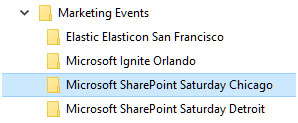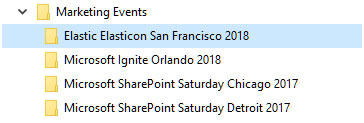The goal of the KISS Taxonomy is to improve the search user experience, as well as provide a faster approach to developing and getting the KISS Taxonomy into users’ hands for refinement and usability feedback versus traditional plodding methods.
The benefits of the KISS taxonomy approach are:
-
- Surfaces the right results in search
-
- Gets users the information they need faster
-
- Reduces the number of refiners needed to get to a result
- Expands a term to get all or better results, making it broader
Broader is better, and we want this to be fast and iterative, and not a three year project. There is one new rule we are going to add before we start building out levels in our hierarchy. The rule is that every term label must have two terms. So, as an example, you can never create a traditional taxonomy that might look like this:

In a KISS taxonomy, you must use two words to describe your term label. This forces you to combine two levels into one. i.e. 1st and 2nd or 3rd and 4th and 5th. There is not a requirement as to which levels, but it forces you to think out your categories, and as you will see, it forces more granularity and description at each level. It is also an important reminder that no matter what, you can only go three levels deep because we want to make the information easy and clickable. This is a KISS taxonomy, and a KISS taxonomy can only be three levels deep!
The above example in a KISS taxonomy might look like this. It takes the above five levels and reduces it to two levels, and every label has at least two words. That reduces the potential number of clicks to get to something by 60% and will make search better too.

Let’s make our above KISS taxonomy a little deeper. Let’s go ahead and add the years of the events. In this case it will be 2017 for SharePoint Saturday and 2018 for Ignite.

Can you guess what the problem is if we go with individual years as above? I hope you are thinking that a year is only one word and there are no one word labels for KISS taxonomies…and then you would be right! So, let’s take the above example and align it with KISS requirements of two words.

It cleans up nicely, doesn’t it? More context per folder/level makes it easier to organize information, and as you will see in Blog 3, it makes it easier to find information too. So, if I were to add the year of the Elastic{ON} conference, would it be another level or would I add it to the current label? You’ve guessed it, we make the label broader or bigger if you are counting terms, which essentially makes it more granular too.

KTI is an agile and iterative process that gets it done fast and is:
-
- Driven by usability versus analytical perfection (users are more important than anything)
-
- Only three levels deep – broader is better
-
- Achievable quickly, providing the ability to measure impact and improve it
- Requires at least two terms per label
In Blog three of this Taxonomy series, we will review where a KISS taxonomy can provide the most value for a company, as well as how it compares to traditional taxonomies. We will also talk about potential tagging approaches and how metadata generation continues to evolve and what to plan for in the near future. Blog four in this series will be about measuring the success of your KISS taxonomy and the most pragmatic ways to get value out of machine learning.


